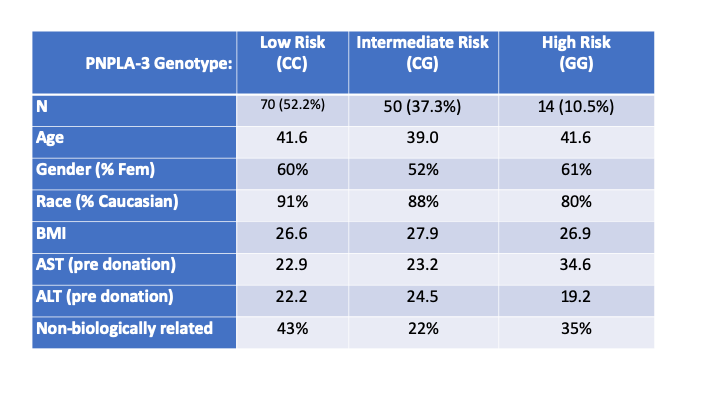Prevalence of Risk Factors for NAFLD among Living Liver Donors
1Surgery, University of Iowa, Iowa CIty, IA, 2Surgery, Lahey Clinic, Burlington, MA, 3University of Colorado, Denver, CA, 4Mass General Hospital, Boston, MA, 5Lahey, Burlington, MA
Meeting: 2020 American Transplant Congress
Abstract number: LB-018
Keywords: Genomics, Living donor, N/A
Session Information
Session Name: Poster Session B: Late Breaking
Session Type: Poster Session
Date: Saturday, May 30, 2020
Session Time: 3:15pm-4:00pm
 Presentation Time: 3:30pm-4:00pm
Presentation Time: 3:30pm-4:00pm
Location: Virtual
*Purpose: The development of non-alcoholic fatty liver (NAFLD) disease has been strongly associated with the presence of polymorphisms in PNPLA3 rs738409. When compared with wild type (CC) carriers, patients with the GG PNPLA3 genotype are 3.5 times more likely to develop NASH. The prevalence of GG phenotype varies by race (higher in Hispanic and Caucasians). The risk of NASH is also increased with BMI>27 and males. Living liver donors have been carefully screened to reduce the risk of long term liver disease using morphometrics, laboratory values, and selective liver biopsy; however, PNPLA3 profiles have not been previously reported.
*Methods: Patients undergoing living donor hepatectomy at a single center from 08/2006 and 02/2016 were retrospectively evaluated. Donor demographic and laboratory data were evaluated. DNA extracted from paraffin embedded liver biopsy obtained at the time of donation was sequenced using the QiaAMP FFPE Tissue Kit. Genotyping was performed on 5 ng of DNA using the PCR and TaqMan SNP Genotyping Assays for PNPLA3 rs738409 Genotypes were assigned using Sequence Detection System (SDS 2.4) software.
*Results: Demographic and genetic data were obtained from 134 donors. In this group, 70 patients were low risk (CC), 50 intermediate risk (GC), and 14 were high risk (GG). There were no significant differences in demographics (Table) Among GG donors, many had additional risk factors for NASH including male gender (48%), BMI> 27 (50%), and younger age (57% were less than 45 years old). 87% of the donors with a high risk genotype had at least one additional risk factor for NASH.
*Conclusions: Living liver donation has been associated with perioperative risks of death and complications. However, long term impact of donation has been assumed to be modest. This study suggests that up to 10% of liver donors deemed acceptable with morphometric and laboratory testing may be a long term risk of NASH due genetic and lifestyle factors. Further research is needed to evaluate the outcomes of these individuals and their suitability for donation.
To cite this abstract in AMA style:
Axelrod DA, Simpson M, Pomfret E, Ehrlich A, Rwema S, Chung R, Gordon F. Prevalence of Risk Factors for NAFLD among Living Liver Donors [abstract]. Am J Transplant. 2020; 20 (suppl 3). https://atcmeetingabstracts.com/abstract/prevalence-of-risk-factors-for-nafld-among-living-liver-donors/. Accessed December 30, 2025.« Back to 2020 American Transplant Congress

